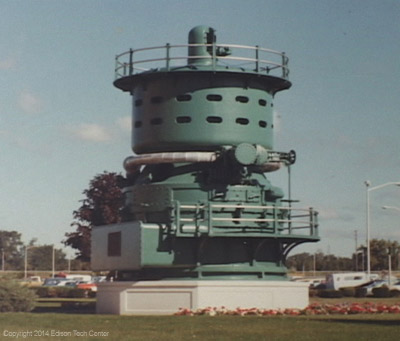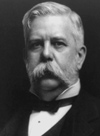Steam Turbines
 Large steam turbine at General Electric |
Steam turbines are found everywhere on the planet and are used to turn
generators and make electricity or create propulsion for ships, airplanes,
missiles.
They convert heat energy in the form of vaporized water into motion using
pressure on spinning blades. This is similar to how hydropower turbines
except that steam moves much faster and the blades and device are very
different.
Steam turbines are used with many sources of energy:
Nuclear
Coal
Fossil Fuels/Natural Gas
Geothermal
Engineers have improved every millimeter of the the steam turbine and
it is one of the most difficult items to design and build. There
are only a few places in the world which make large steam turbines.
Large steam turbine manufacturers:
General Electric. Schenectady, NY
Siemens, Germany
Weir Allen Steam Turbines, Brazil
Elliot Group, Sodegaura Japan, Jeanette PA
|
Large steam turbine rotor under construction in Schenectady, NY (photo: General Electric) |
History:
The idea of a steam turbine has been around since 100 AD. Modern steam turbines developed from the reciprocating steam engine typical of the 19th century. Early innovators like George Westinghouse knew that the back and forth motion of reciprocating steam engines wasted a lot of energy and that if the steam could be channeled into a narrow space and pressure used to turn a shaft, it would result in the maximum energy efficiency.
Timeline:
1712 - Steam engine with piston developed by Thomas Newcomen
1781 - James Watt develops first steam engine that produces a continuous rotating motion
1831 - DeWitt Clinton, first regular train service in North America runs Albany to Schenectady, NY runs on a reciprocating steam engine. After this the steam engine's use grows and the field of mechanical engineering officially begins.
1884 - Sir Charles Parsons builds the first real steam turbine. The knowledge required to build this came from
1885 - George Westinghouse buys steam turbine patents and starts improvements
1896 - Charles Curtis develops a turbine that weighs 1/8th as much as existing turbines and was 1/10th the size for the same power
 |
1903 - Curtis and William
Le Roy Emmet develop the 5000 kW vertical turbine for General Electric,
this turbine created enormous amount of of power in a compact space only
25' high. Every major power station in the US wanted this at the time.
1900s - Steam turbines got smaller and smaller while power increased.
Some turbines produce up to 500,000 kW.
Below: an Edison Tech Center video on the early history of steam turbines with historian George Wise:
How it Works:
Steam turbines force high pressure steam through multistage rotors, meaning many sets of blades extract all the possible energy from the pressure.
For more detail see TurbineGenerator.org >
CO-Generation:
Cogen turbines have two separate generations in the same stream of power, this extracts the maximum energy out of the hot stream of steam. They can have efficiencies of over 80% in comparison to typical steam turbine plants which have about 40%.
Related topics:
Gas Turbines
Hydro (water turbines)
Related Topics:
|
Diesel Electric Locomotives |
Steam Trains |
Electric Cars |

George Westinghouse |
Gas Turbines |
Dynamos and Generators |
Sources:
Wabash Power Equipment Company
General Electric
Siemens
Turbocam International
Wikipedia
Elliott Group
ASME
Schenectady Museum


